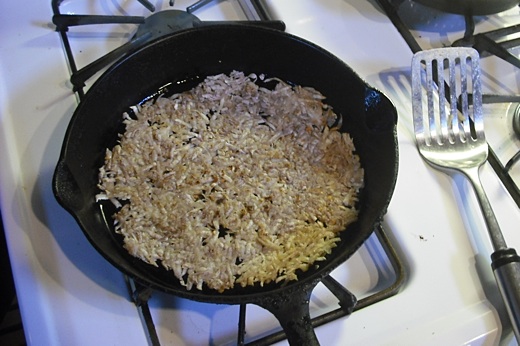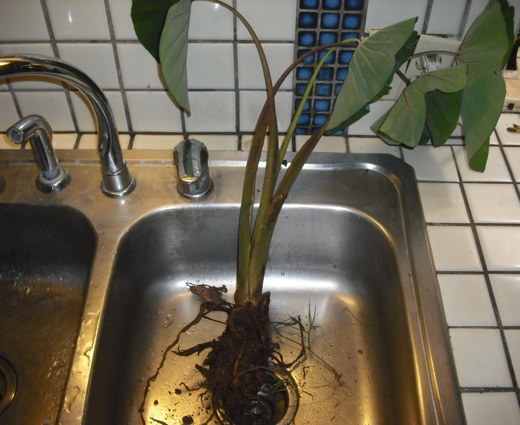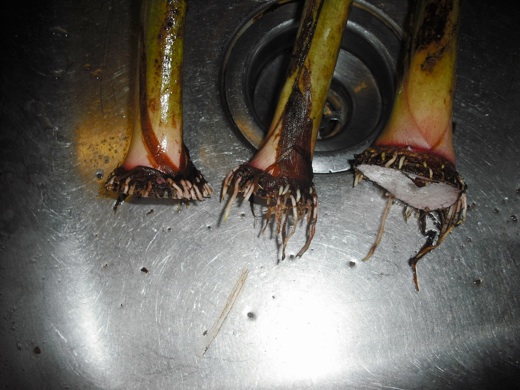SUBHEAD: Chinese variety dryland taro makes a great substitute for a McDonald's hashbrown.
By Juan Wilson on 19 December 2009 for Island Breath -
(http://islandbreath.blogspot.com/2009/12/taro-hashbrowns.html)
[Authors update 9/26/12: For a while we have been freezing taro corms after trimming and cleaning them (seee second photo below). The frozen corms change their texture after thawing. I believe the freeze/thaw cycle helps break down the calcium oxalate. When shredding and frying the thawed taro I've found it cooks faste, is stickier and seems to have less irritation for those sensitive to calcium oxalate.]

Image above: Mostly loco-vore breakfast. Eggs, papaya/lime, orange juice, and taro hashbrown from yard. Coffee from nearby Kauai Coffee. Catsup and turkey bacon from God-knows-where via Eleele Big Save Supermarket. All photos by Juan Wilson.
We've been growing dryland taro for five years in our backyard. See Island Breath: Backyard Taro Farmer. My favorite use of them is as a hashbrown for breakfast. Before you try any taro recipe you should realize that in its raw form taro is toxic, due to the presence of calcium oxalate, although the toxin is destroyed by cooking.
The calcium oxalate can be removed a long boil or, according to Wikipedia, by steeping taro roots in cold water overnight. It is also good to determine how sensitive you are to the calcium oxalate. I have a pretty high tolerance to it, whereas my wife is quite sensitive. She generally has no problem eating the taro prepared as hashbrowns. For my hashbrowns I neither boil or steep the roots (corms). Note, as far as I know this is only possible with the varieties of dryland taro that are low in calcium oxalate, to begin with. These varieties are white inside, rather than lined with a purple pinkish color.

Image above: Trimmed and cleaned dryland taro corms. Note how free of pink spots they are.
One medium size corn will provide 2-3 hashbrown servings. Peel the dark brown skin off the taro corm. The peeled skin should include the purple and pink layer below. From what I understand this is where there is the greatest concentration of calcium oxalate. Note the peeled corm has a soapy, slippery texture, so be careful of your knuckles on the grater... or leave a little skin on the corm to form a good grip.

Image above: A halfway shredded taro corm almost ready for seasoning.
Once shredded I add a pinch of Hanapepe sea salt, some black pepper and a generous amount of powdered garlic. Adding some minced fresh garlic as a nicety too. The shredded taro sticks quite well to itself. Just put the shreds in the preheated high temperature safflower oil. Spread and flatten the taro out to fill the bottom of a 10" cast iron skillet. The trick to taking care of the calcium oxalate is to press the taro very thin (1/8"). This process will make a the taro into something like a pan fried chipate. It will cling together, so that you can flip it like a pan-sized pancake. Cook the big hashbrown thoroughly on both sides.

Image above: Shredded taro flattened and fried in oil on both sides until browned.
This can takes about ten to fifteen minutes. The hashbrown is ready when it is slightly browned on both sides and crispy. I fold it in half and continue heating it for a few minutes. When the eggs and turkey bacon are done I cut the big semicircular hashbrown into some pie shaped wedges for serving. A little catsup on the side works well with a dash of hot sauce. Happy Breakfast! If you grow your own taro...

Image above: a fresh picked dryland taro plant from backyard ready to be washed and trimmed.
You want to harvest only the few plants you will need for no longer than a week or so. Care must be taken to cut the corm (root) off the plant without damaging the seam between the out-of-ground portion and the rooting portion. This is so the upper part of the plant can be replanted to regrow another corm. All but the most inner (newest) leaf stem should be clipped off the plant for replanting (so as not to waste plant energy).

Image above: Trimmed upper part of taro plants ready for re-planting in ground.
Taro plants do not have to be replanted immediately. Even a week after harvest plants can be viable. I recommend wrapping them in a moist towel and keeping them in a shaded place if you are going to wait to replant them.
See also:
Island Breath: Ulu - The Breadfruit Tree 12/31/06
Ea O Ka Aina: Get out your Ulu 7/19/09
Ea O Ka Aina: Peak Macadamia Nut 9/22/09
Ea O Ka Aina: Green Turtle Mango 10/13/09
Ea O Ka Aina: Green Papaya Sauerkraut 10/14/09
Ea O Ka Aina: Breadfruit Experiments 11/15/09
By Juan Wilson on 19 December 2009 for Island Breath -
(http://islandbreath.blogspot.com/2009/12/taro-hashbrowns.html)
[Authors update 9/26/12: For a while we have been freezing taro corms after trimming and cleaning them (seee second photo below). The frozen corms change their texture after thawing. I believe the freeze/thaw cycle helps break down the calcium oxalate. When shredding and frying the thawed taro I've found it cooks faste, is stickier and seems to have less irritation for those sensitive to calcium oxalate.]

Image above: Mostly loco-vore breakfast. Eggs, papaya/lime, orange juice, and taro hashbrown from yard. Coffee from nearby Kauai Coffee. Catsup and turkey bacon from God-knows-where via Eleele Big Save Supermarket. All photos by Juan Wilson.
We've been growing dryland taro for five years in our backyard. See Island Breath: Backyard Taro Farmer. My favorite use of them is as a hashbrown for breakfast. Before you try any taro recipe you should realize that in its raw form taro is toxic, due to the presence of calcium oxalate, although the toxin is destroyed by cooking.
The calcium oxalate can be removed a long boil or, according to Wikipedia, by steeping taro roots in cold water overnight. It is also good to determine how sensitive you are to the calcium oxalate. I have a pretty high tolerance to it, whereas my wife is quite sensitive. She generally has no problem eating the taro prepared as hashbrowns. For my hashbrowns I neither boil or steep the roots (corms). Note, as far as I know this is only possible with the varieties of dryland taro that are low in calcium oxalate, to begin with. These varieties are white inside, rather than lined with a purple pinkish color.

Image above: Trimmed and cleaned dryland taro corms. Note how free of pink spots they are.
One medium size corn will provide 2-3 hashbrown servings. Peel the dark brown skin off the taro corm. The peeled skin should include the purple and pink layer below. From what I understand this is where there is the greatest concentration of calcium oxalate. Note the peeled corm has a soapy, slippery texture, so be careful of your knuckles on the grater... or leave a little skin on the corm to form a good grip.

Image above: A halfway shredded taro corm almost ready for seasoning.
Once shredded I add a pinch of Hanapepe sea salt, some black pepper and a generous amount of powdered garlic. Adding some minced fresh garlic as a nicety too. The shredded taro sticks quite well to itself. Just put the shreds in the preheated high temperature safflower oil. Spread and flatten the taro out to fill the bottom of a 10" cast iron skillet. The trick to taking care of the calcium oxalate is to press the taro very thin (1/8"). This process will make a the taro into something like a pan fried chipate. It will cling together, so that you can flip it like a pan-sized pancake. Cook the big hashbrown thoroughly on both sides.

Image above: Shredded taro flattened and fried in oil on both sides until browned.
This can takes about ten to fifteen minutes. The hashbrown is ready when it is slightly browned on both sides and crispy. I fold it in half and continue heating it for a few minutes. When the eggs and turkey bacon are done I cut the big semicircular hashbrown into some pie shaped wedges for serving. A little catsup on the side works well with a dash of hot sauce. Happy Breakfast! If you grow your own taro...

Image above: a fresh picked dryland taro plant from backyard ready to be washed and trimmed.
You want to harvest only the few plants you will need for no longer than a week or so. Care must be taken to cut the corm (root) off the plant without damaging the seam between the out-of-ground portion and the rooting portion. This is so the upper part of the plant can be replanted to regrow another corm. All but the most inner (newest) leaf stem should be clipped off the plant for replanting (so as not to waste plant energy).

Image above: Trimmed upper part of taro plants ready for re-planting in ground.
Taro plants do not have to be replanted immediately. Even a week after harvest plants can be viable. I recommend wrapping them in a moist towel and keeping them in a shaded place if you are going to wait to replant them.
See also:
Island Breath: Ulu - The Breadfruit Tree 12/31/06
Ea O Ka Aina: Get out your Ulu 7/19/09
Ea O Ka Aina: Peak Macadamia Nut 9/22/09
Ea O Ka Aina: Green Turtle Mango 10/13/09
Ea O Ka Aina: Green Papaya Sauerkraut 10/14/09
Ea O Ka Aina: Breadfruit Experiments 11/15/09
1 comment :
Howdy Y'all!
I haven't really read this article, but I did eat all that good stuff for breakfast here at Juan's house this morning, and it was super delicious!
What a great, healthy, economical, and planet friendly way to start the day!
Thank You Juan!!!
Post a Comment